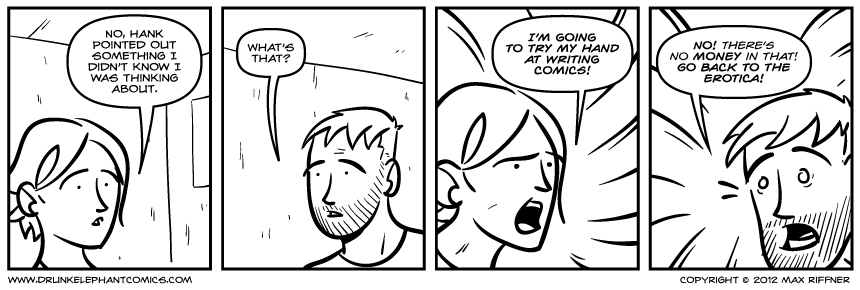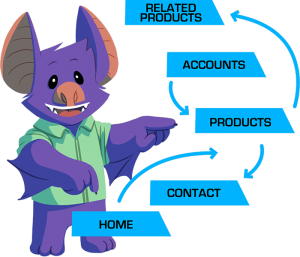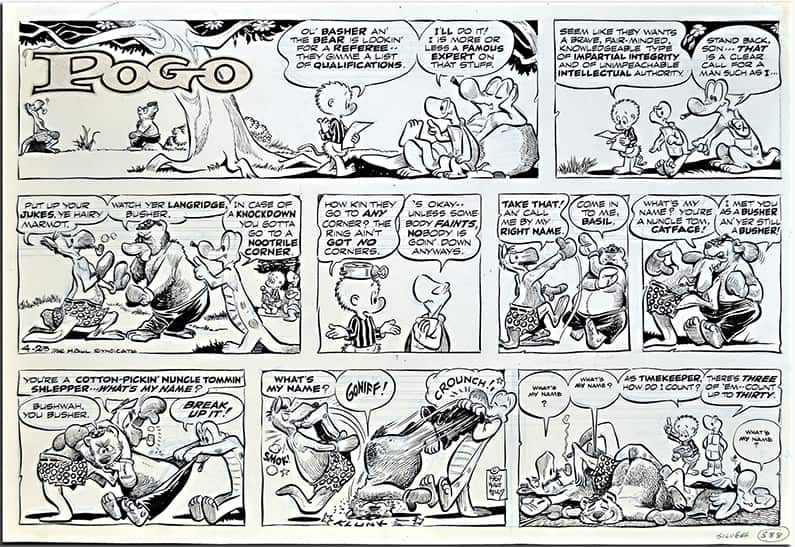The two biggest issues facing a cartoonist today are finding an audience and making a living. It’s hard to find either in today’s marketplace. In every other industry, the way to seperate your business from your competitors1 is through marketing. And cartoonists are horrible at marketing themselves. But there is a way to help themselves by way of content marketing. Webcomics are the perfect vehicle for that.

Already making webcomics?
If you are making a webcomic, you have probably noticed some intangible effects from it. I believe that publishing a webcomic is worth doing from a marketing perspective. A webcomic can help you find a loyal audience, serve as a portfolio piece, and get your foot in the door with publishers. This post is for cartoonists who haven’t experimented with putting their work online.
What is Content Marketing?
Content marketing is creating and sharing free content that can help convert customers. It’s blogs, podcasts, e-books, infographics, how-to guides. Back when the web was first getting started, just having a website was a competitive advantage. The process of getting online was painful, too. In the 90s, it wasn’t uncommon to take up to 6 months to create a website. Now that every business is online, content marketing helps distinguish them from their competition. And with today’s software, the speed of making content and websites is incredible.
The last 5 years or so have seen brands ratchet up their content marketing efforts. Most of what I do in the interactive space is related to content marketing. The good thing about it, if you are doing it right, is that it helps people. Good content gets rewarded by readers, search engines, and social media.
Webcomics: Cheap Marketing for Cartoonists
Most small press cartoonists today only use conventions to distribute their work and for networking. Going to conventions and selling your comics is expensive. On average, half a table at a show is going to cost you $300–600. And that doesn’t include travel or printing costs. Few people make their investment back. If the true cost of a convention is more than $1000, you have to sell a lot of comics to make that back. This is especially true if you live some place where there aren’t many conventions in your geographic vicinity.
What if I could tell you how to do more with just $120 a year investment? That’s it. That’s all it takes to find a cheap web host. With a website, your potential audience is much larger. And with great content, you are giving that audience a reason to keep coming back to your website. Your content? It’s your comics. And you don’t have to travel anywhere, or print and ship a load of books. Plus, the software that most of us use for our websites is free.
Building your website and webcomic
Once you have a domain name and hosting secured, you need to set up a website. For most people, I’d recommend WordPress. It’s free. It is extensible with plugins, including some webcomic specific plugins. You can install it with most web hosts using a One Click Install program. You can also set up a store for yourself using WooCommerce to sell your pages. I know a lot of cartoonists like using Big Cartel for its store management. But with a little elbow grease, you can build your own. And it isn’t hard.
For people who aren’t comfortable with that, Squarespace is a good option to look into. They take care of everything. I don’t think their SEO options are fantastic. And you may have to make some workarounds to post comics, but it’s a dead simple option.
 For those that have some comfort with setting up websites, I want to recommend using Grawlix. I’m supporting them on their Patreon, and I think they are doing some great work. It’s a content management system built only for webcomics. I’m going to be using their software soon.
For those that have some comfort with setting up websites, I want to recommend using Grawlix. I’m supporting them on their Patreon, and I think they are doing some great work. It’s a content management system built only for webcomics. I’m going to be using their software soon.
For those that have a lot of comfort with technology, I’m bullish on flat file systems, like Jekyll and Hugo. If you don’t know what a flat file system is, just ignore this part. I built a large webcomic with Textpattern, a content management system near and dear to my heart. Again, you have to know what you are doing, but it works how you want it to work. Definitely worth a look.
Finding an audience on social media
Once you start posting your comics on your website, you aren’t done. This isn’t Field of Dreams. You need to share it. And the best way to do that is with social media. Twitter, Facebook, and Tumblr are going to be the channels you see the most success with.
Twitter is how I found the bulk of my fans. It’s great for sharing comics. You probably already have an account. Just start posting your comics there. Include a link and a panel from your comic, and post in the evenings. You’ll see a higher engagement at that time, but experiment. It doesn’t cost you anything but time. I find that the evenings and mid-mornings work best for me. If you are starting a webcomic, I don’t know if I would recommend starting a seperate Twitter account. It’s a double-edged sword. If you do, you can lock in the username you want for intellectual property purposes. But you won’t see as much engagement as you would from your personal account. Just be aware of that.
I would set up a Facebook Page for yourself, and maybe your comic if it is ongoing. Again, you are going to see better engagement from your personal account if you post there also. But there are benefits to the Facebook Page. One is that you don’t have to “friend” your fans, or feel obligated to. Another is with a Page, you have access to Facebook’s incredible advertising platform. For dollars a day, you can target a potential audience at a specific level. It’s fascinating how you can filter it. Facebook’s advertising used to be kind of a joke in digital marketing circles. Now it’s quite amazing and powerful.
Tumblr
A lot of cartoonists I know use Tumblr as their website. I’m here to tell you why you shouldn’t:
- You don’t control it. Yahoo controls it. And Yahoo screwed the pooch with Flickr and their company is kind of a tire fire right now. In all likelihood they are going to sell it. And who knows where it goes from there.
- Since you don’t control it, you don’t know what sort of ownership is happening with your content.
Tumblr is a social media channel, and it has a strong community. I’m not saying don’t use it. But don’t use it as your main website/digital hub. Also, it has incredible SEO value because all its links posted there are follow links. If you don’t know what that means, you don’t need to. Just use it. Post links and teasers to your comic there. And experiment. Have an exit plan. Just in case. It might not be around forever. WordPress has plugins to automatically post there when you update your site.
Buffer or HootSuite: Social Media Management
With all these social media platforms you are posting to, it can get old logging into them for updates. Good news! There is software to help you. Buffer and HootSuite are web applications that will help manage your social media accounts. Post once, and they will distribute your posts to the apporpriate channels. They both have free options available.
Build an email list
The best way to engage digitally with your fans is to build an email list. I recommend MailChimp. It’s free up to 1000 subscribers and most website software supports it. You can even set it up to automatically send out emails based on your content posting schedule via RSS.
I recommend setting up an automated email to go out via MailChimp with the offer of a free digital comic. You can set up Gumroad for a digital download (or, again, WooCommerce) with a promo code for a digital comic. Post that as an automated email in MailChimp for free subscribers. That gives them an incentive to sign up. Then, when you have a new comic that is being released, you have a direct connection to that audience.
There are other email marketing providers. The only other one I’d recommend is Campaign Monitor. You have to pay to use it, but it’s affordable. Constant Contact and Emma are two others services. I’ve hit up against their limitations more than I’d like.
Hit a convention
Okay, I know I’ve just written about 1500 words about digital promotion. But nothing beats promoting yourself in a physical location. Take your time at this step. Research conventions that are a good fit for your comics. And look at the professionals attending for networking possibilities. I would recommend not getting a table for a bit and going to some conventions as a fan. Bring some books, but just for trading and networking.
When you have an audience, get a table and cut your costs. Cut corners wherever you can. Be ruthless. You work hard for the money you earn and invest in your art.
I haven’t had a table for 9 years and have gone to cons only to network. This strategy has worked better for me than having a table. I will get a table again in the future, but for now, I like this method. I’m not chained to my table trying to earn money back. I get to work the floor and meet people.
Drunk Elephant Comics

My webcomic, Drunk Elephant Comics, ran from 2008 through 2012. I learned a lot from publishing it online. Not only about marketing and promotion of a comic, but about the art of cartooning. I earned a loyal following of fans through that webcomic. It also led into some great professional opportunities for me.
Which is why I’m bringing it back.
In the years since I haven’t been putting out new webcomics, I feel like something has been missing in my life. While I was putting out Drunk Elephant Comics, I kept gaining new fans. That has slowed down. And as I look at how I’ll be releasing new work shortly (The Walk), I wonder how I can help promote it? Drunk Elephant Comics was content marketing for myself, as a brand and an artist.
When I graduated from CCS, I was ready to do longer stories. Graphic novels. And when I started Drunk Elephant, I felt like I was struggling with that all the time. I wanted to make another graphic novel and didn’t appreciate the strip format. I gained appreciation for comic strips during my journey. So I’m going to try it again, this time with all the knowledge I’ve acquired since then.
I’ll write more about the technical aspects of how I’m going to do it, but Hank is coming back soon. Two other projects are in the pipeline that I hope to release online also. I will also be setting up a Patreon that will support all three comics.
2016 is going to be a busy year.
- I don’t believe that other cartoonists are in competition with each other. Your audience isn’t necessarily my audience, and also, fans like all sorts of comics. We’re all in this together. ↩︎




